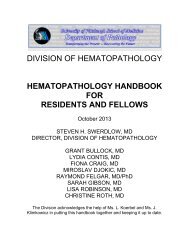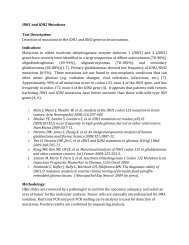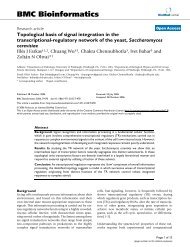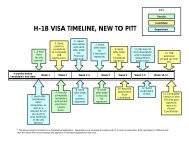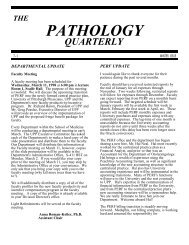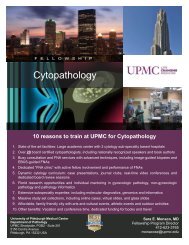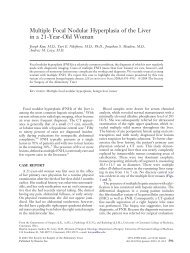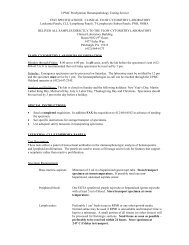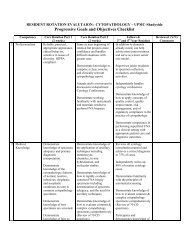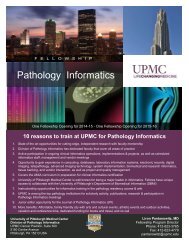molecular pathways and therapeutic targets. Mod Pathol. 2008 May
molecular pathways and therapeutic targets. Mod Pathol. 2008 May
molecular pathways and therapeutic targets. Mod Pathol. 2008 May
Create successful ePaper yourself
Turn your PDF publications into a flip-book with our unique Google optimized e-Paper software.
NIH-PA Author Manuscript NIH-PA Author Manuscript NIH-PA Author Manuscript<br />
NIH Public Access<br />
Author Manuscript<br />
<strong>Mod</strong> <strong>Pathol</strong>. Author manuscript; available in PMC 2009 <strong>May</strong> 1.<br />
Published in final edited form as:<br />
<strong>Mod</strong> <strong>Pathol</strong>. <strong>2008</strong> <strong>May</strong> ; 21(Suppl 2): S37–S43. doi:10.1038/modpathol.<strong>2008</strong>.10.<br />
Thyroid Carcinoma: Molecular Pathways <strong>and</strong> Therapeutic Targets<br />
Yuri E. Nikiforov, M.D., Ph.D.<br />
Department of <strong>Pathol</strong>ogy <strong>and</strong> Laboratory Medicine, University of Pittsburgh Medical Center,<br />
Pittsburgh, PA<br />
Abstract<br />
Thyroid cancer is the most common malignant tumor of the endocrine system. The most frequent<br />
type of thyroid malignancy is papillary carcinoma. These tumors frequently have genetic alterations<br />
leading to the activation of the mitogen-activated protein kinase (MAPK) signaling pathway. Most<br />
common mutations in papillary carcinomas are point mutations of the BRAF <strong>and</strong> RAS genes <strong>and</strong><br />
RET/PTC rearrangement. These genetic alterations are found in >70% of papillary carcinomas <strong>and</strong><br />
they rarely overlap in the same tumor. Most frequent alterations in follicular carcinomas, the second<br />
most common type of thyroid malignancy, include RAS mutations <strong>and</strong> PAX8-PPARγ rearrangement.<br />
RET point mutations are crucial for the development of medullary thyroid carcinomas. Many of these<br />
mutations, particularly those leading to the activation of the MAPK pathway, are being actively<br />
explored as <strong>therapeutic</strong> <strong>targets</strong> for thyroid cancer. A number of compounds have been studied <strong>and</strong><br />
showed antitumor effects in preclinical studies <strong>and</strong> are being tested in ongoing clinical trials.<br />
Keywords<br />
BRAF<br />
thyroid cancer; mutations; MAPK; BRAF; RET; inhibitors<br />
Thyroid cancer is the most common malignant tumor of the endocrine system <strong>and</strong> accounts<br />
for approximately 1% of all newly diagnosed cancer cases [1]. The most frequent type of<br />
thyroid malignancy is papillary carcinoma, which constitutes ∼80% of all cases. Papillary<br />
carcinomas frequently have genetic alterations leading to the activation of the mitogenactivated<br />
protein kinase (MAPK) signaling pathway (Fig. 1). Those include RET/PTC<br />
rearrangement <strong>and</strong> point mutations of the BRAF <strong>and</strong> RAS genes. Mutations involving one of<br />
these genes are found in >70% of papillary carcinomas <strong>and</strong> they rarely overlap in the same<br />
tumor [2-4] (Table 1). Frequent genetic alterations in follicular carcinomas, the second most<br />
common type of thyroid malignancy, include RAS mutations <strong>and</strong> PAX8-PPARγ rearrangement.<br />
RET point mutations are crucial for the development of medullary thyroid carcinomas. Many<br />
of these mutations, particularly those leading to the activation of the MAPK pathway, are being<br />
actively explored as <strong>therapeutic</strong> <strong>targets</strong> for thyroid cancer.<br />
BRAF serine-threonine kinase belongs to the family of RAF proteins, which are intracellular<br />
effectors of the MAPK signalling cascade. Upon activation triggered by RAS binding <strong>and</strong><br />
protein recruitment to the cell membrane, these kinases phosphorylate <strong>and</strong> activate MEK,<br />
which in turn activates ERK <strong>and</strong> consequent effectors of the MAPK cascade.<br />
Corresponding author/address for reprints: Dr. Yuri Nikiforov, Department of <strong>Pathol</strong>ogy, University of Pittsburgh, A713 Scaife Hall,<br />
3550 Terrace Street, Pittsburgh, PA 15261, E-mail address: E-mail: nikiforovye@upmc.edu.
Nikiforov Page 2<br />
NIH-PA Author Manuscript NIH-PA Author Manuscript NIH-PA Author Manuscript<br />
RET/PTC<br />
Point mutations of the BRAF gene are found in ∼45% of thyroid papillary carcinomas [2,5].<br />
Virtually all point mutations involve nucleotide 1799 <strong>and</strong> result in a valine-to-glutamate<br />
substitution at residue 600 (V600E) [6,7]. BRAF V600E mutation leads to constitutive<br />
activation of BRAF kinase <strong>and</strong> the mechanism of activations has been recently elucidated. In<br />
the dephosphorylated, wild-type BRAF protein, the hydrophobic interactions between the<br />
activation loop <strong>and</strong> the ATP binding site maintain the protein in an inactive conformation. The<br />
V600E substitution disrupts these interactions <strong>and</strong> allows the formation of new interactions<br />
that keep the protein in a catalytically competent conformation, resulting in continuous<br />
phosphorylation of MEK [8].<br />
BRAF mutations are highly prevalent in papillary carcinomas with classical histology <strong>and</strong> in<br />
the tall cell variant, but are rare in the follicular variant [6,9]. In many studies, the presence of<br />
BRAF mutation has been found to correlate with aggressive tumor characteristics such as<br />
extrathyroidal extension, advanced tumor stage at presentation, tumor recurrence, <strong>and</strong> lymph<br />
node or distant metastases [10-12]. Importantly, BRAF V600E has been found to be an<br />
independent predictor of tumor recurrence even in patients with stage I-II of the disease [12,<br />
13]. BRAF mutations have also been associated with the decreased ability of tumors to trap<br />
radioiodine <strong>and</strong> treatment failure of the recurrent disease, which may be due to the<br />
dysregulation of function of the sodium iodide symporter (NIS) <strong>and</strong> other genes metabolizing<br />
iodide in thyroid follicular cells [12,14].<br />
Other <strong>and</strong> rare mechanisms of BRAF activation in papillary thyroid cancer include K601E<br />
point mutation, small in-frame insertions or deletions surrounding codon 600 [15-17], <strong>and</strong><br />
AKAP9-BRAF rearrangement, which is more common in papillary carcinomas associated with<br />
radiation exposure [18].<br />
In addition to papillary carcinomas, BRAF is found mutated in thyroid anaplastic <strong>and</strong> poorly<br />
differentiated carcinomas, typically in those tumors that also contain areas of well<br />
differentiated papillary carcinoma [10,11,19]. In these tumors, BRAF mutation is detectable in<br />
both well differentiated <strong>and</strong> poorly differentiated or anaplastic tumor areas, providing evidence<br />
that it occurs early in the tumorigenesis.<br />
The RET proto-oncogene codes for a cell membrane receptor tyrosine kinase. In the thyroid<br />
gl<strong>and</strong>, RET is highly expressed in parafollicular C-cells but not in follicular cells, where it can<br />
be activated by chromosomal rearrangement known as RET/PTC rearrangement [20,21]. In<br />
RET/PTC, the 3′ portion of the RET gene is fused to the 5′ portion of various unrelated genes.<br />
At least 11 types of RET/PTC have been reported to date, all formed by the RET fusion to<br />
different partners [22,23]. The two most common rearrangement types, RET/PTC1 <strong>and</strong> RET/<br />
PTC3, account for the vast majority of all rearrangements found in papillary carcinomas. RET/<br />
PTC1 is formed by fusion with the H4 (D10S170) gene, <strong>and</strong> RET/PTC3 by fusion with the<br />
NCOA4 (ELE1) gene [21,24]. The fusion leaves intact the TK domain of the RET receptor<br />
<strong>and</strong> enables the RET/PTC oncoprotein to bind SHC <strong>and</strong> activate the RAS-RAF-MAPK cascade<br />
[25].<br />
RET/PTC is tumorigenic in thyroid follicular cells as it transforms thyroid cells in culture<br />
[26] <strong>and</strong> gives rise to thyroid carcinomas in transgenic mice [27-29]. Several studies suggest<br />
that the oncogenic effects of RET/PTC require signalling along the MAPK pathway <strong>and</strong> the<br />
presence of the functional BRAF kinase [25,30,31]. Indeed, BRAF silencing in cultured thyroid<br />
cells reverses the RET/PTC-induced effects such as ERK phosphorylation, inhibition of<br />
thyroid-specific gene expression, <strong>and</strong> increased cell proliferation [30,31].<br />
<strong>Mod</strong> <strong>Pathol</strong>. Author manuscript; available in PMC 2009 <strong>May</strong> 1.
Nikiforov Page 3<br />
NIH-PA Author Manuscript NIH-PA Author Manuscript NIH-PA Author Manuscript<br />
RAS<br />
PAX8-PPARγ<br />
RET/PTC is found on average in ∼20% of adult sporadic papillary carcinomas, although its<br />
prevalence is highly variable between different observations [22,23]. In general, RET/PTC<br />
incidence is higher in tumors from patients with the history of radiation exposure <strong>and</strong> in<br />
pediatric populations. The distribution of RET/PTC rearrangement within each tumor may vary<br />
from involving almost all neoplastic cells (clonal RET/PTC) to being detected only in a small<br />
fraction of tumor cells (non-clonal RET/PTC) [32,33]. The heterogeneity may be of a potential<br />
problem for the RET receptor-targeted therapy, since tumors with non-clonal RET/PTC<br />
frequently have other genetic alterations <strong>and</strong> may not respond to RET inhibitors in the same<br />
way as tumors harboring the clonal rearrangement.<br />
Papillary carcinomas with RET/PTC rearrangements typically present at younger age <strong>and</strong> have<br />
a high rate of lymph node metastases, classic papillary histology <strong>and</strong> possibly more favorable<br />
prognosis, particularly those harboring RET/PTC1 [9]. In tumors arising after radiation<br />
exposure, RET/PTC1 was found to be associated with classic papillary histology, whereas<br />
RET/PTC3 type was more common in the solid variants [34].<br />
The RAS genes (H-RAS, K-RAS, <strong>and</strong> N-RAS) encode highly related G-proteins that are located<br />
at the inner surface of the cell membrane <strong>and</strong> play a central role in the intracellular transduction<br />
of signals arising from cell membrane receptors tyrosine kinase <strong>and</strong> G-protein-coupled<br />
receptors. In its inactive state, RAS protein is bound to guanosine diphosphate (GDP). Upon<br />
activation, it releases GDP <strong>and</strong> binds guanosine triphosphate (GTP), activating the MAPK <strong>and</strong><br />
other signaling pathway, such as PI3K/AKT. Normally, the activated RAS-GTP protein<br />
becomes quickly inactive due to its intrinsic guanosine triphosphatase (GTPase) activity <strong>and</strong><br />
the action of cytoplasmic GTPase-activating proteins, which catalyze the conversion of the<br />
active GTP form to the inactive GDP-bound form. In many human neoplasms, point mutations<br />
occur in the discrete domains of the RAS gene, which result in either an increased affinity for<br />
GTP (mutations in codons 12 <strong>and</strong> 13) or inactivation of the autocatalytic GTPase function<br />
(mutations in codon 61). As a result, the mutant protein becomes permanently switched in the<br />
active position <strong>and</strong> constitutively actives its downstream signaling <strong>pathways</strong>.<br />
Point mutations of RAS occur with variably frequency in all types of thyroid follicular cellderived<br />
tumors. In papillary carcinomas, RAS mutations are relatively infrequent, as they occur<br />
in ∼10% of tumors [35,36]. Papillary carcinomas with RAS mutations almost always have the<br />
follicular variant histology; this mutation also correlates with significantly less prominent<br />
nuclear features of papillary carcinoma, more frequent encapsulation, <strong>and</strong> low rate of lymph<br />
node metastases [9,37]. Some studies have reported the association between RAS mutations<br />
<strong>and</strong> more aggressive behavior of papillary carcinoma <strong>and</strong> with higher frequency of distant<br />
metastases [38]. In follicular thyroid carcinomas, RAS mutations are found in 40-50% of tumors<br />
[39-41] <strong>and</strong> may also correlate with tumor dedifferentiation <strong>and</strong> less favorable prognosis [42,<br />
43]. RAS mutations may predispose to tumor dedifferentiation, as they are found with high<br />
prevalence in anaplastic (undifferentiated) thyroid carcinomas. This may be due to the effect<br />
of mutant RAS to promote chromosomal instability, which has been documented in the in vitro<br />
setting [44,45]. RAS mutations, however, are not specific for thyroid malignancy <strong>and</strong> also occur<br />
in benign follicular adenomas.<br />
PAX8-PPARγ rearrangement results from the translocation t(2;3)(q13;p25) that leads to the<br />
fusion between the PAX8 gene, which encodes a paired domain transcription factor, <strong>and</strong> the<br />
peroxisome proliferator-activated receptor (PPARγ) gene [46]. PAX8-PPARγ occurs in ∼35%<br />
of conventional follicular carcinomas, <strong>and</strong> with lower prevalence in oncocytic (Hurthle cell)<br />
<strong>Mod</strong> <strong>Pathol</strong>. Author manuscript; available in PMC 2009 <strong>May</strong> 1.
Nikiforov Page 4<br />
NIH-PA Author Manuscript NIH-PA Author Manuscript NIH-PA Author Manuscript<br />
carcinomas [47-49]. Tumors harboring PAX8-PPARγ tend to present at a younger age, be<br />
smaller in size, <strong>and</strong> more frequently have vascular invasion. The rearrangement results in<br />
overexpression of the PPARγ protein that can be detected by immunohistochemistry [46,50].<br />
The mechanisms of cell transformation induced by PAX8-PPARγ are not fully understood.<br />
Some evidence has been presented for inhibition of normal PPARγ function via a dominant<br />
negative effect of the PAX8-PPARγ protein on wild-type PPARγ [46,51]. Other studies have<br />
found the activation of known PPAR target genes in tumors harboring PAX8-PPARγ, arguing<br />
against the dominant negative effect [52]. Other possible mechanisms include deregulation of<br />
PAX8 function, known to be critical for thyroid cell differentiation, <strong>and</strong> activation of a set of<br />
genes related to neither wild-type PPARγ nor wild-type PAX8 <strong>pathways</strong> [52,53].<br />
PAX8-PPARγ rearrangements <strong>and</strong> RAS point mutations rarely overlap in the same tumor,<br />
suggesting that follicular carcinomas may develop via at least two distinct <strong>molecular</strong> pathway,<br />
initiated by either PAX8-PPARγ or RAS mutation [48].<br />
RET Point Mutations<br />
Targeted Therapies<br />
Alteration of the RET proto-oncogene plays a causal role in the familial forms of medullary<br />
thyroid carcinoma <strong>and</strong> has also been found in sporadic forms of the disease. In medullary<br />
carcinomas, RET is activated by point mutation, in contrast to its activation by chromosomal<br />
rearrangement in papillary thyroid carcinomas. Germline mutations in the discrete functional<br />
regions of RET are found in almost all patients with familial forms of medullary carcinoma.<br />
In MEN 2A <strong>and</strong> familial medullary carcinoma, mutations are typically located in one of five<br />
cysteine codons within the cysteine-rich extracellular domain [54]. Almost 90% of MEN 2A<br />
mutations affect codon 634, whereas in familial medullary carcinoma they are more evenly<br />
distributed along the cysteine-rich region [55]. These mutations result in unpairing of cysteine<br />
residues in the extracellular domain leading to formation of disulfide bonds between two<br />
mutated receptor molecules <strong>and</strong> lig<strong>and</strong>-independent dimerization <strong>and</strong> constitutive activation<br />
of RET kinase [56]. In MEN 2B, the majority of germline mutations occur in codon 918 in the<br />
intracellular tyrosine kinase domain of RET. This mutation is believed to alters the substrate<br />
specificity of RET kinase, resulting in phosphorylation of unusual intracellular proteins [56].<br />
In sporadic medullary carcinomas, somatic mutations of RET are found in 20-80% of cases<br />
[57,58]. The vast majority of those affect codon 918, although they have also been identified<br />
in few other regions of the gene. Some of these somatic mutations have heterogeneous<br />
distribution within the tumor or are detected only in a subset of metastatic nodules, raising<br />
concerns that they may not be essential for carcinogenesis [58].<br />
Well differentiated papillary <strong>and</strong> follicular carcinomas typically have indolent behavior <strong>and</strong><br />
can be effectively treated by surgery followed by radioiodine therapy. However, tumors that<br />
loose differentiation <strong>and</strong> therefore ability to trap radioiodine or unresectable follicular-cell<br />
derided tumors together with C-cell derived medullary carcinomas do not respond to<br />
radioiodine treatment <strong>and</strong> usually have a much less favorable prognosis. Those tumors are<br />
obvious c<strong>and</strong>idates for alternative <strong>therapeutic</strong> approaches such as <strong>molecular</strong>ly targeted therapy.<br />
Several small-molecule tyrosine kinase inhibitors directed towards RET kinase have been<br />
tested in preclinical <strong>and</strong> clinical studies. ZD6474, an orally active low <strong>molecular</strong> weight<br />
receptor tyrosine kinase inhibitor, is a potent inhibitor of the vascular endothelial growth factor<br />
receptor 2 (VEGFR-2) <strong>and</strong> effectively blocks RET tyrosine kinase [59]. ZD6474 has been<br />
shown to block phosphorylation <strong>and</strong> signaling from RET/PTC3 <strong>and</strong> RET carrying most<br />
common MEN2A <strong>and</strong> MEN2B mutations in vitro, to induce growth arrest of human papillary<br />
<strong>Mod</strong> <strong>Pathol</strong>. Author manuscript; available in PMC 2009 <strong>May</strong> 1.
Nikiforov Page 5<br />
NIH-PA Author Manuscript NIH-PA Author Manuscript NIH-PA Author Manuscript<br />
carcinoma cell lines carrying RET/PTC1 <strong>and</strong> to prevent tumor growth in nude mice after<br />
injection of RET/PTC3-transformed fibroblasts or RET-mutation positive medullary<br />
carcinoma cells [60,61].<br />
Some evidence of response to the ZD6474 therapy has been reported in patients with metastatic<br />
familial medullary carcinoma in clinical trials [59]. A multi-center phase II double blinded<br />
study is currently open to compare the efficacy of ZD6474 (ZACTIMA, AstraZeneca<br />
Pharmaceuticals, DE, USA) versus placebo in patients with unresectable locally advanced or<br />
metastatic medullary carcinoma. This large <strong>and</strong> well-controlled study is expected to provide<br />
conclusive evidence for the <strong>therapeutic</strong> efficacy of this compound in inherited <strong>and</strong> sporadic<br />
medullary thyroid carcinomas.<br />
Since antitumor activity of ZD6474 is likely due to a combination of its anti-RET activity <strong>and</strong><br />
antiangiogenic activity mediated by blocking VEGFR, it will be of importance to found<br />
whether the extent of the <strong>therapeutic</strong> response to ZD6474 depends on the presence of RET<br />
mutation <strong>and</strong> its type. In preclinical studies, ZD6474 has been shown to inhibit most of the<br />
mutated variants of RET, except for the V804L <strong>and</strong> V804M mutations [62]. V804 in the RET<br />
protein corresponds to the gate-keeper residues of ABL, PDGFR, c-KIT, <strong>and</strong> EGFR kinases,<br />
<strong>and</strong> mutations at these residues are known to confer resistance to various inhibitors [63]. These<br />
suggest that RET V804L <strong>and</strong> V804M mutations in medullary carcinomas may mediate primary<br />
resistance to ZD6474 [62].<br />
Two other small-molecule tyrosine kinase inhibitors, the pyrazolopyrimidine compounds PP1<br />
<strong>and</strong> PP2, have been tested in preclinical studies <strong>and</strong> found to be effective in <strong>therapeutic</strong><br />
concentrations in blocking RET/PTC signaling in vivo <strong>and</strong> abolishing its tumorigenic effects<br />
in experimental animals [64,65]. A multi-kinase inhibitor SU12248 (Sunitinib) has been show<br />
to effectively inhibit signaling from RET/PTC kinase in the experimental models <strong>and</strong> has been<br />
progressed to phase II clinical trial in radioiodine-refractory, unresectable differentiated<br />
thyroid cancer <strong>and</strong> medullary thyroid cancer [66].<br />
Various BRAF inhibitors have been identified <strong>and</strong> tested as potential <strong>therapeutic</strong> agents. They<br />
would be particularly valuable for thyroid cancer treatment due to the high frequency of<br />
BRAF mutation in these tumors <strong>and</strong> its association with tumor dedifferentiation <strong>and</strong> resistance<br />
to the conventional radioiodine therapy. Moreover, since in the signaling cascade BRAF is<br />
downstream of RET <strong>and</strong> RAS, BRAF inhibitors may be potentially effective in tumors with<br />
other mutations affecting this signaling pathway.<br />
BAY 43-9006 is a multi-kinase inhibitor with potent activity against RAF, VEGFR-2,<br />
VEGFR-3, PDGFRβ, FLT-3, <strong>and</strong> c-KIT kinases [67]. Orally administered BAY 43-9006 has<br />
shown strong antitumor effect in xenograft models of several type of cancer, <strong>and</strong> this effect is<br />
believed to be due to inhibition of MAPK signalling by blocking RAF <strong>and</strong> of angiogenesis by<br />
blocking VEGFR-2,-3 <strong>and</strong> other kinases involved in tumor neovascularization [67].<br />
Importantly for the thyroid cancer field, BAY 43-9006 effectively blocks the wild-type BRAF<br />
<strong>and</strong> the mutant V600E BRAF kinase activity, although its effect on V600E BRAF is slightly<br />
less potent than on the wild-type BRAF kinase [8,67]. BAY 43-9006 inhibit the BRAF<br />
signalling <strong>and</strong> growth of all thyroid cell lines carrying the mutant BRAF [68]. It impaired the<br />
growth of the anaplastic carcinoma cell line xenografts in nude mice, <strong>and</strong> large areas of necrosis<br />
were found in the xenografts after the treatment of animals for 5 days [68]. The inhibition of<br />
growth was mainly a cytostatic effect due to the cell arrest in G1 phase, <strong>and</strong> more profound<br />
cell death could be mediated by the inhibition of other kinases, especially those involved in<br />
angiogenesis. More recently, BAY 43-9006 <strong>therapeutic</strong> effect has also been found on cells<br />
carrying the activated forms of RET, including RET/PTC [69].<br />
<strong>Mod</strong> <strong>Pathol</strong>. Author manuscript; available in PMC 2009 <strong>May</strong> 1.
Nikiforov Page 6<br />
NIH-PA Author Manuscript NIH-PA Author Manuscript NIH-PA Author Manuscript<br />
Acknowledgements<br />
References<br />
BAY 43-9006 has been tested in clinical trials for several cancer types, including thyroid<br />
cancer. Preliminary results of the trial in patients with progressive papillary carcinoma have<br />
shown minimal or partial response in some patients [70,71]. However, the complete results of<br />
this study as well other ongoing phase II trials of BAY 43-9006 (Sorafenib) in anaplastic thyroid<br />
carcinoma <strong>and</strong> metastatic medullary thyroid carcinoma are yet to be released. It will be<br />
important to find whether the response to BAY 43-9006 correlates with tumor phenotype <strong>and</strong><br />
presence of BRAF or other mutations.<br />
The effects of other inhibitors of RAF kinases, AAL-881 <strong>and</strong> LBT-613, have been explored<br />
in thyroid cells in preclinical studies [72]. Both compounds were found to block the MAPK<br />
signalling <strong>and</strong> growth of rat thyroid cells <strong>and</strong> human thyroid tumor cell lines harboring the<br />
V600E BRAF <strong>and</strong> RET/PTC1. Suppression of the growth of BRAF mutant tumor xenografts<br />
in nude mice was also noted. However, some of these anti-cancer effects may be due to offtarget<br />
effects, since they also occurred in the absence of inhibition of MEK <strong>and</strong> ERK<br />
phosphorylation [72,73].<br />
Additional <strong>and</strong> potentially very effective <strong>therapeutic</strong> target along the MAPK pathway are<br />
located downstream of BRAF. A non-ATP competitive MEK inhibitor CI-1040 has been found<br />
to abrogate tumor growth in BRAF mutant xenografts derived from various tumor types <strong>and</strong><br />
has progressed to clinical trials [74].<br />
As the results of ongoing clinical trials are expected to be available in the near future <strong>and</strong> testing<br />
of novel kinase inhibitors continues, this information is expected to allow more precise<br />
assessment of the role of <strong>molecular</strong> inhibitors, administered alone or in combination, in the<br />
therapy of thyroid cancer.<br />
This study was supported by NIH grant R01 CA88041.<br />
1. Hundahl SA, Fleming ID, Fremgen AM, et al. A National Cancer Data Base report on 53,856 cases<br />
of thyroid carcinoma treated in the U.S., 1985-1995. Cancer 1998;83:2638–2648. [PubMed: 9874472]<br />
2. Kimura ET, Nikiforova MN, Zhu Z, et al. High prevalence of BRAF mutations in thyroid cancer:<br />
genetic evidence for constitutive activation of the RET/PTC-RAS-BRAF signaling pathway in<br />
papillary thyroid carcinoma. Cancer Res 2003;63:1454–1457. [PubMed: 12670889]<br />
3. Fagin JA. Genetics of papillary thyroid cancer initiation: implications for therapy. Transactions of the<br />
American Clinical <strong>and</strong> Climatological Association 2005;116:259–269. [PubMed: 16555619]<br />
discussion 269-271<br />
4. Kondo T, Ezzat S, Asa SL. Pathogenetic mechanisms in thyroid follicular-cell neoplasia. Nature<br />
reviews 2006;6:292–306.<br />
5. Cohen Y, Xing M, Mambo E, et al. BRAF mutation in papillary thyroid carcinoma. J Natl Cancer Inst<br />
2003;95:625–627. [PubMed: 12697856]<br />
6. Xing M. BRAF mutation in thyroid cancer. Endocr Relat Cancer 2005;12:245–262. [PubMed:<br />
15947100]<br />
7. Ciampi R, Nikiforov YE. Alterations of the BRAF gene in thyroid tumors. Endocr <strong>Pathol</strong> 2005;16:163–<br />
172. [PubMed: 16299399]<br />
8. Wan PT, Garnett MJ, Roe SM, et al. Mechanism of activation of the RAF-ERK signaling pathway by<br />
oncogenic mutations of B-RAF. Cell 2004;116:855–867. [PubMed: 15035987]<br />
9. Adeniran AJ, Zhu Z, G<strong>and</strong>hi M, et al. Correlation between genetic alterations <strong>and</strong> microscopic features,<br />
clinical manifestations, <strong>and</strong> prognostic characteristics of thyroid papillary carcinomas. Am J Surg<br />
<strong>Pathol</strong> 2006;30:216–222. [PubMed: 16434896]<br />
<strong>Mod</strong> <strong>Pathol</strong>. Author manuscript; available in PMC 2009 <strong>May</strong> 1.
Nikiforov Page 7<br />
NIH-PA Author Manuscript NIH-PA Author Manuscript NIH-PA Author Manuscript<br />
10. Nikiforova MN, Kimura ET, G<strong>and</strong>hi M, et al. BRAF mutations in thyroid tumors are restricted to<br />
papillary carcinomas <strong>and</strong> anaplastic or poorly differentiated carcinomas arising from papillary<br />
carcinomas. J Clin Endocrinol Metab 2003;88:5399–5404. [PubMed: 14602780]<br />
11. Namba H, Nakashima M, Hayashi T, et al. Clinical implication of hot spot BRAF mutation, V599E,<br />
in papillary thyroid cancers. J Clin Endocrinol Metab 2003;88:4393–4397. [PubMed: 12970315]<br />
12. Xing M, Westra WH, Tufano RP, et al. BRAF mutation predicts a poorer clinical prognosis for<br />
papillary thyroid cancer. J Clin Endocrinol Metab 2005;90:6373–6379. [PubMed: 16174717]<br />
13. Kim TY, Kim WB, Rhee YS, et al. The BRAF mutation is useful for prediction of clinical recurrence<br />
in low-risk patients with conventional papillary thyroid carcinoma. Clin Endocrinol (Oxf)<br />
2006;65:364–368. [PubMed: 16918957]<br />
14. Riesco-Eizaguirre G, Gutierrez-Martinez P, Garcia-Cabezas MA, et al. The oncogene BRAF V600E<br />
is associated with a high risk of recurrence <strong>and</strong> less differentiated papillary thyroid carcinoma due<br />
to the impairment of Na+/I- targeting to the membrane. Endocr Relat Cancer 2006;13:257–269.<br />
[PubMed: 16601293]<br />
15. Trovisco V, Vieira de Castro I, Soares P, et al. BRAF mutations are associated with some histological<br />
types of papillary thyroid carcinoma. J <strong>Pathol</strong> 2004;202:247–251. [PubMed: 14743508]<br />
16. Carta C, Moretti S, Passeri L, et al. Genotyping of an Italian papillary thyroid carcinoma cohort<br />
revealed high prevalence of BRAF mutations, absence of RAS mutations <strong>and</strong> allowed the detection<br />
of a new mutation of BRAF oncoprotein (BRAF(V599lns)). Clin Endocrinol (Oxf) 2006;64:105–<br />
109. [PubMed: 16402937]<br />
17. Hou P, Liu D, Xing M. Functional characterization of the T1799-1801del <strong>and</strong> A1799-1816ins BRAF<br />
mutations in papillary thyroid cancer. Cell Cycle 2007;6:377–379. [PubMed: 17297294]<br />
18. Ciampi R, Knauf JA, Kerler R, et al. Oncogenic AKAP9-BRAF fusion is a novel mechanism of<br />
MAPK pathway activation in thyroid cancer. J Clin Invest 2005;115:94–101. [PubMed: 15630448]<br />
19. Begum S, Rosenbaum E, Henrique R, et al. BRAF mutations in anaplastic thyroid carcinoma:<br />
implications for tumor origin, diagnosis <strong>and</strong> treatment. <strong>Mod</strong> <strong>Pathol</strong> 2004;17:1359–1363. [PubMed:<br />
15195111]<br />
20. Fusco A, Grieco M, Santoro M, et al. A new oncogene in human thyroid papillary carcinomas <strong>and</strong><br />
their lymph-nodal metastases. Nature 1987;328:170–172. [PubMed: 3600795]<br />
21. Grieco M, Santoro M, Berlingieri MT, et al. PTC is a novel rearranged form of the ret proto-oncogene<br />
<strong>and</strong> is frequently detected in vivo in human thyroid papillary carcinomas. Cell 1990;60:557–563.<br />
[PubMed: 2406025]<br />
22. Nikiforov YE. RET/PTC Rearrangement in Thyroid Tumors. Endocr <strong>Pathol</strong> 2002;13:3–16. [PubMed:<br />
12114746]<br />
23. Tallini G, Asa SL. RET oncogene activation in papillary thyroid carcinoma. Adv Anat <strong>Pathol</strong><br />
2001;8:345–354. [PubMed: 11707626]<br />
24. Santoro M, Dathan NA, Berlingieri MT, et al. Molecular characterization of RET/PTC3; a novel<br />
rearranged version of the RETproto-oncogene in a human thyroid papillary carcinoma. Oncogene<br />
1994;9:509–516. [PubMed: 8290261]<br />
25. Knauf JA, Kuroda H, Basu S, et al. RET/PTC-induced dedifferentiation of thyroid cells is mediated<br />
through Y1062 signaling through SHC-RAS-MAP kinase. Oncogene 2003;22:4406–4412.<br />
[PubMed: 12853977]<br />
26. Santoro M, Melillo RM, Grieco M, et al. The TRK <strong>and</strong> RET tyrosine kinase oncogenes cooperate<br />
with ras in the neoplastic transformation of a rat thyroid epithelial cell line. Cell Growth Differ<br />
1993;4:77–84. [PubMed: 8494786]<br />
27. Jhiang SM, Sagartz JE, Tong Q, et al. Targeted expression of the ret/PTC1 oncogene induces papillary<br />
thyroid carcinomas. Endocrinology 1996;137:375–378. [PubMed: 8536638]<br />
28. Santoro M, Chiappetta G, Cerrato A, et al. Development of thyroid papillary carcinomas secondary<br />
to tissue-specific expression of the RET/PTC1 oncogene in transgenic mice. Oncogene<br />
1996;12:1821–1826. [PubMed: 8622903]<br />
29. Powell DJ Jr, Russell J, Nibu K, et al. The RET/PTC3 oncogene: metastatic solid-type papillary<br />
carcinomas in murine thyroids. Cancer Res 1998;58:5523–5528. [PubMed: 9850089]<br />
<strong>Mod</strong> <strong>Pathol</strong>. Author manuscript; available in PMC 2009 <strong>May</strong> 1.
Nikiforov Page 8<br />
NIH-PA Author Manuscript NIH-PA Author Manuscript NIH-PA Author Manuscript<br />
30. Melillo RM, Castellone MD, Guarino V, et al. The RET/PTC-RAS-BRAF linear signaling cascade<br />
mediates the motile <strong>and</strong> mitogenic phenotype of thyroid cancer cells. J Clin Invest 2005;115:1068–<br />
1081. [PubMed: 15761501]<br />
31. Mitsutake N, Knauf JA, Mitsutake S, et al. Conditional BRAFV600E expression induces DNA<br />
synthesis, apoptosis, dedifferentiation, <strong>and</strong> chromosomal instability in thyroid PCCL3 cells. Cancer<br />
Res 2005;65:2465–2473. [PubMed: 15781663]<br />
32. Zhu Z, Ciampi R, Nikiforova MN, et al. Prevalence of Ret/Ptc Rearrangements in Thyroid Papillary<br />
Carcinomas: Effects of the Detection Methods <strong>and</strong> Genetic Heterogeneity. J Clin Endocrinol Metab.<br />
2006<br />
33. Unger K, Zitzelsberger H, Salvatore G, et al. Heterogeneity in the distribution of RET/PTC<br />
rearrangements within individual post-Chernobyl papillary thyroid carcinomas. J Clin Endocrinol<br />
Metab 2004;89:4272–4279. [PubMed: 15356021]<br />
34. Nikiforov YE, Rowl<strong>and</strong> JM, Bove KE, et al. Distinct pattern of ret oncogene rearrangements in<br />
morphological variants of radiation-induced <strong>and</strong> sporadic thyroid papillary carcinomas in children.<br />
Cancer Res 1997;57:1690–1694. [PubMed: 9135009]<br />
35. Namba H, Rubin SA, Fagin JA. Point mutations of ras oncogenes are an early event in thyroid<br />
tumorigenesis. Mol Endocrinol 1990;4:1474–1479. [PubMed: 2283998]<br />
36. Ezzat S, Zheng L, Kolenda J, et al. Prevalence of activating ras mutations in morphologically<br />
characterized thyroid nodules. Thyroid 1996;6:409–416. [PubMed: 8936664]<br />
37. Zhu Z, G<strong>and</strong>hi M, Nikiforova MN, et al. Molecular profile <strong>and</strong> clinical-pathologic features of the<br />
follicular variant of papillary thyroid carcinoma. An unusually high prevalence of ras mutations. Am<br />
J Clin <strong>Pathol</strong> 2003;120:71–77. [PubMed: 12866375]<br />
38. Hara H, Fulton N, Yashiro T, et al. N-ras mutation: an independent prognostic factor for<br />
aggressiveness of papillary thyroid carcinoma. Surgery 1994;116:1010–1016. [PubMed: 7985080]<br />
39. Lemoine NR, <strong>May</strong>all ES, Wyllie FS, et al. High frequency of ras oncogene activation in all stages of<br />
human thyroid tumorigenesis. Oncogene 1989;4:159–164. [PubMed: 2648253]<br />
40. Suarez HG, du Villard JA, Severino M, et al. Presence of mutations in all three ras genes in human<br />
thyroid tumors. Oncogene 1990;5:565–570. [PubMed: 2183158]<br />
41. Motoi N, Sakamoto A, Yamochi T, et al. Role of ras mutation in the progression of thyroid carcinoma<br />
of follicular epithelial origin. <strong>Pathol</strong> Res Pract 2000;196:1–7. [PubMed: 10674266]<br />
42. Basolo F, Pisaturo F, Pollina LE, et al. N-ras mutation in poorly differentiated thyroid carcinomas:<br />
correlation with bone metastases <strong>and</strong> inverse correlation to thyroglobulin expression. Thyroid<br />
2000;10:19–23. [PubMed: 10691309]<br />
43. Garcia-Rostan G, Zhao H, Camp RL, et al. ras mutations are associated with aggressive tumor<br />
phenotypes <strong>and</strong> poor prognosis in thyroid cancer. J Clin Oncol 2003;21:3226–3235. [PubMed:<br />
12947056]<br />
44. Fagin JA. Minireview: br<strong>and</strong>ed from the start-distinct oncogenic initiating events may determine<br />
tumor fate in the thyroid. Mol Endocrinol 2002;16:903–911. [PubMed: 11981026]<br />
45. Saavedra HI, Knauf JA, Shirokawa JM, et al. The RAS oncogene induces genomic instability in<br />
thyroid PCCL3 cells via the MAPK pathway. Oncogene 2000;19:3948–3954. [PubMed: 10951588]<br />
46. Kroll TG, Sarraf P, Pecciarini L, et al. PAX8-PPARgamma1 fusion oncogene in human thyroid<br />
carcinoma [corrected]. Science 2000;289:1357–1360. [PubMed: 10958784]<br />
47. French CA, Alex<strong>and</strong>er EK, Cibas ES, et al. Genetic <strong>and</strong> biological subgroups of low-stage follicular<br />
thyroid cancer. Am J <strong>Pathol</strong> 2003;162:1053–1060. [PubMed: 12651598]<br />
48. Nikiforova MN, Lynch RA, Biddinger PW, et al. RAS point mutations <strong>and</strong> PAX8-PPAR gamma<br />
rearrangement in thyroid tumors: evidence for distinct <strong>molecular</strong> <strong>pathways</strong> in thyroid follicular<br />
carcinoma. J Clin Endocrinol Metab 2003;88:2318–2326. [PubMed: 12727991]<br />
49. Dwight T, Thoppe SR, Foukakis T, et al. Involvement of the PAX8/peroxisome proliferator-activated<br />
receptor gamma rearrangement in follicular thyroid tumors. The Journal of clinical endocrinology<br />
<strong>and</strong> metabolism 2003;88:4440–4445. [PubMed: 12970322]<br />
50. Nikiforova MN, Biddinger PW, Caudill CM, et al. PAX8-PPARgamma rearrangement in thyroid<br />
tumors: RT-PCR <strong>and</strong> immunohistochemical analyses. Am J Surg <strong>Pathol</strong> 2002;26:1016–1023.<br />
[PubMed: 12170088]<br />
<strong>Mod</strong> <strong>Pathol</strong>. Author manuscript; available in PMC 2009 <strong>May</strong> 1.
Nikiforov Page 9<br />
NIH-PA Author Manuscript NIH-PA Author Manuscript NIH-PA Author Manuscript<br />
51. Gregory Powell J, Wang X, Allard BL, et al. The PAX8/PPARgamma fusion oncoprotein transforms<br />
immortalized human thyrocytes through a mechanism probably involving wild-type PPARgamma<br />
inhibition. Oncogene 2004;23:3634–3641. [PubMed: 15077183]<br />
52. Giordano TJ, Au AY, Kuick R, et al. Delineation, functional validation, <strong>and</strong> bioinformatic evaluation<br />
of gene expression in thyroid follicular carcinomas with the PAX8-PPARG translocation. Clin<br />
Cancer Res 2006;12:1983–1993. [PubMed: 16609007]<br />
53. Reddi HV, McIver B, Grebe SK, et al. The paired box-8/peroxisome proliferator-activated receptorgamma<br />
oncogene in thyroid tumorigenesis. Endocrinology 2007;148:932–935. [PubMed: 16946003]<br />
54. Mulligan LM, Marsh DJ, Robinson BG, et al. Genotype-phenotype correlation in multiple endocrine<br />
neoplasia type 2: report of the International RET Mutation Consortium. J Intern Med 1995;238:343–<br />
346. [PubMed: 7595170]<br />
55. Hansford JR, Mulligan LM. Multiple endocrine neoplasia type 2 <strong>and</strong> RET: from neoplasia to<br />
neurogenesis. J Med Genet 2000;37:817–827. [PubMed: 11073534]<br />
56. Santoro M, Melillo RM, Carlomagno F, et al. Molecular biology of the MEN2 gene. Journal of internal<br />
medicine 1998;243:505–508. [PubMed: 9681850]<br />
57. Alberti L, Carniti C, Mir<strong>and</strong>a C, et al. RET <strong>and</strong> NTRK1 proto-oncogenes in human diseases. Journal<br />
of cellular physiology 2003;195:168–186. [PubMed: 12652644]<br />
58. Eng C, Mulligan LM, Healey CS, et al. Heterogeneous mutation of the RET proto-oncogene in<br />
subpopulations of medullary thyroid carcinoma. Cancer research 1996;56:2167–2170. [PubMed:<br />
8616867]<br />
59. Herbst RS, Heymach JV, O'Reilly MS, et al. V<strong>and</strong>etanib (ZD6474): an orally available receptor<br />
tyrosine kinase inhibitor that selectively <strong>targets</strong> <strong>pathways</strong> critical for tumor growth <strong>and</strong> angiogenesis.<br />
Expert opinion on investigational drugs 2007;16:239–249. [PubMed: 17243944]<br />
60. Carlomagno F, Vitagliano D, Guida T, et al. ZD6474, an orally available inhibitor of KDR tyrosine<br />
kinase activity, efficiently blocks oncogenic RET kinases. Cancer Res 2002;62:7284–7290.<br />
[PubMed: 12499271]<br />
61. Santoro M, Carlomagno F. Drug insight: Small-molecule inhibitors of protein kinases in the treatment<br />
of thyroid cancer. Nature clinical practice 2006;2:42–52.<br />
62. Carlomagno F, Guida T, Anaganti S, et al. Disease associated mutations at valine 804 in the RET<br />
receptor tyrosine kinase confer resistance to selective kinase inhibitors. Oncogene 2004;23:6056–<br />
6063. [PubMed: 15184865]<br />
63. Pao W, Miller VA. Epidermal growth factor receptor mutations, small-molecule kinase inhibitors,<br />
<strong>and</strong> non-small-cell lung cancer: current knowledge <strong>and</strong> future directions. J Clin Oncol 2005;23:2556–<br />
2568. [PubMed: 15767641]<br />
64. Carlomagno F, Vitagliano D, Guida T, et al. The kinase inhibitor PP1 blocks tumorigenesis induced<br />
by RET oncogenes. Cancer Res 2002;62:1077–1082. [PubMed: 11861385]<br />
65. Carlomagno F, Vitagliano D, Guida T, et al. Efficient inhibition of RET/papillary thyroid carcinoma<br />
oncogenic kinases by 4-amino-5-(4-chloro-phenyl)-7-(t-butyl)pyrazolo[3,4-d]pyrimidine (PP2). J<br />
Clin Endocrinol Metab 2003;88:1897–1902. [PubMed: 12679489]<br />
66. Kim DW, Jo YS, Jung HS, et al. An orally administered multitarget tyrosine kinase inhibitor,<br />
SU11248, is a novel potent inhibitor of thyroid oncogenic RET/papillary thyroid cancer kinases. The<br />
Journal of clinical endocrinology <strong>and</strong> metabolism 2006;91:4070–4076. [PubMed: 16849418]<br />
67. Wilhelm SM, Carter C, Tang L, et al. BAY 43-9006 exhibits broad spectrum oral antitumor activity<br />
<strong>and</strong> <strong>targets</strong> the RAF/MEK/ERK pathway <strong>and</strong> receptor tyrosine kinases involved in tumor progression<br />
<strong>and</strong> angiogenesis. Cancer research 2004;64:7099–7109. [PubMed: 15466206]<br />
68. Salvatore G, De Falco V, Salerno P, et al. BRAF is a <strong>therapeutic</strong> target in aggressive thyroid<br />
carcinoma. Clin Cancer Res 2006;12:1623–1629. [PubMed: 16533790]<br />
69. Carlomagno F, Anaganti S, Guida T, et al. BAY 43-9006 inhibition of oncogenic RET mutants. J<br />
Natl Cancer Inst 2006;98:326–334. [PubMed: 16507829]<br />
70. Baudin E, Schlumberger M. New <strong>therapeutic</strong> approaches for metastatic thyroid carcinoma. The lancet<br />
oncology 2007;8:148–156. [PubMed: 17267329]<br />
71. Espinosa AV, Porchia L, Ringel MD. Targeting BRAF in thyroid cancer. British journal of cancer<br />
2007;96:16–20. [PubMed: 17179987]<br />
<strong>Mod</strong> <strong>Pathol</strong>. Author manuscript; available in PMC 2009 <strong>May</strong> 1.
Nikiforov Page 10<br />
NIH-PA Author Manuscript NIH-PA Author Manuscript NIH-PA Author Manuscript<br />
72. Ouyang B, Knauf JA, Smith EP, et al. Inhibitors of Raf kinase activity block growth of thyroid cancer<br />
cells with RET/PTC or BRAF mutations in vitro <strong>and</strong> in vivo. Clin Cancer Res 2006;12:1785–1793.<br />
[PubMed: 16551863]<br />
73. Chiloeches A, Marais R. Is BRAF the Achilles' Heel of thyroid cancer? Clin Cancer Res<br />
2006;12:1661–1664. [PubMed: 16551846]<br />
74. Solit DB, Garraway LA, Pratilas CA, et al. BRAF mutation predicts sensitivity to MEK inhibition.<br />
Nature 2006;439:358–362. [PubMed: 16273091]<br />
<strong>Mod</strong> <strong>Pathol</strong>. Author manuscript; available in PMC 2009 <strong>May</strong> 1.
Nikiforov Page 11<br />
NIH-PA Author Manuscript NIH-PA Author Manuscript NIH-PA Author Manuscript<br />
Fig. 1.<br />
The mitogen-activated protein kinase (MAPK) signaling pathway is physiologically activated<br />
by binding of growth factors to receptor tyrosine kinases (RTKs), such RET <strong>and</strong> NTRK,<br />
resulting in receptor dimerization <strong>and</strong> activation via autophosphorylation of tyrosine residues<br />
in the intracellular domain. The activated receptor, through a series of adaptor proteins, leads<br />
to activation of RAS located at the inner face of the plasma membrane. The activated RAS<br />
binds to <strong>and</strong> recruits RAF proteins (mainly BRAF in thyroid follicular cells) to the plasma<br />
membrane. Activated BRAF phosphorylates <strong>and</strong> activate the mitogen-activated protein kinase/<br />
ERK kinase (MEK), which in turn phosphorylates <strong>and</strong> activates the extracellular-signalregulated<br />
kinase (ERK). Activated ERK translocates into the nucleus, where it regulates<br />
transcription of the genes involved in cell differentiation, proliferation <strong>and</strong> survival. Alterations<br />
of this pathway in thyroid cancer can occur at different levels as a result of point mutation or<br />
rearrangement involving the RET, RAS, <strong>and</strong> BRAF genes.<br />
<strong>Mod</strong> <strong>Pathol</strong>. Author manuscript; available in PMC 2009 <strong>May</strong> 1.
Nikiforov Page 12<br />
Table 1<br />
Average prevalence of mutations in thyroid cancer<br />
NIH-PA Author Manuscript NIH-PA Author Manuscript NIH-PA Author Manuscript<br />
Tumor Type<br />
Prevalence<br />
Papillary Carcinoma<br />
BRAF 45%<br />
RET/PTC 20%<br />
RAS 10%<br />
TRK



